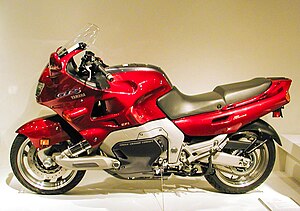Yamaha Motor Co., Ltd. is a Japanese multinational manufacturer of motorcycles, marine products such as boats and outboard motors, and other motorized products. The company was established in 1955 upon separation from Yamaha Corporation, and is headquartered in Iwata, Shizuoka, Japan. The company conducts development, production and marketing operations through 109 consolidated subsidiaries as of 2012.

Universal Japanese Motorcycle (UJM) is a term for Japanese standard motorcycles coined in the 1970s. It referred to motorcycles made by Japanese manufacturers that made motorcycles more accessible to common people. It commonly refers to Japanese motorcycles made for commuting with a four-stroke and inline four-cylinder engine. By around 1990 its popularity began to wane as the market fragmented into more specialized designs.
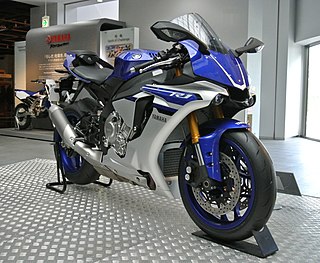
The Yamaha YZF-R1, or simply R1, is a 1,000 cc (61 cu in)-class sports motorcycle made by Yamaha. It was first released in 1998, undergoing significant updates in 2000, 2002, 2004, 2006, 2007, 2009, 2015, 2018 and 2020.

A sport bike is a motorcycle designed and optimized for speed, acceleration, braking, and cornering on asphalt concrete race tracks and roads. They are mainly designed for performance at the expense of comfort, fuel economy, and storage in comparison with other motorcycles.

The six main types of motorcycles are generally recognized as standard, cruiser, touring, sports, off-road, and dual-purpose. Sport touring is sometimes recognized as a seventh category or integrated with the touring category.

The Yamaha FJR1300A and FJR1300AE/AS are sport touring motorcycles made by Yamaha Motor Company. Both models have a 1,298 cc inline-four engine. The AE/AS model has an electronically controlled clutch and gear shifting system called YCC-S. The clutch and transmissions of the AE/AS models are identical to that of the standard FJR model.
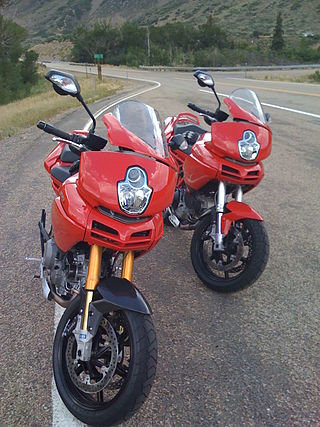
First introduced in 2003, the Ducati Multistrada is a series of V-twin and V4 touring focused motorcycles. Essentially a hybrid of a supermoto and a sport-tourer, the Multistrada competes in the market with other dual-sport motorcycles such as the BMW GS. The first iteration of the Multistrada was, like the Yamaha TDM850, neither intended nor suitable for off-road use. Subsequent models were more suited to a proper dual-sport role.

The Honda CBR1000RR, marketed in some countries as the "Fireblade", is a 999 cc (61.0 cu in) liquid-cooled inline four-cylinder superbike, introduced by Honda in 2004 as the 7th generation of the CBR series of motorcycles that began with the CBR900RR in 1990.
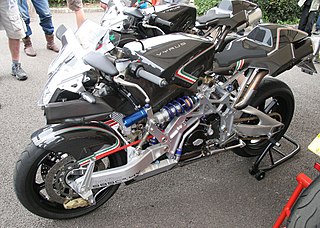
Hub-center steering (HCS) is one of several different types of front-end suspension/steering mechanisms used in motorcycles and cargo bicycles. Hub-center steering is characterized by the steering pivot points being inside the hub of the wheel, rather than above the wheel in the headstock as in the traditional layout. Most hub-center arrangements employ a swingarm that extends from the bottom of the engine/frame to the center of the front wheel.

The Yamaha XS Eleven motorcycle, also called XS11 and XS1100, is a Japanese standard produced from 1978 to 1981, powered by an air-cooled 1,101 cc (67.2 cu in) 4-stroke, DOHC inline four-cylinder engine mounted transversely in a duplex cradle frame with swingarm rear suspension, shaft drive, and telescopic forks.
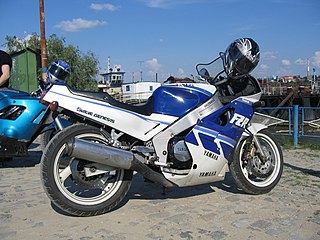
The Yamaha FZR1000 is a motorcycle produced by Yamaha from 1987 to 1995. Classed as a sports motorcycle.
A motorcycle's suspension serves a dual purpose: contributing to the vehicle's handling and braking, and providing safety and comfort by keeping the vehicle's passengers comfortably isolated from road noise, bumps and vibrations.

A motorcycle fork connects a motorcycle's front wheel and axle to its frame, typically via a yoke, also known as a triple clamp, which consists of an upper yoke joined to a lower yoke via a steering stem, a shaft that runs through the steering head, creating the steering axis. Most forks incorporate the front suspension and front brake, and allow the front wheel to rotate about the steering axis so that the bike may be steered. Most handlebars attach to the top clamp in various ways, while clip-on handlebars clamp to the fork tubes, either just above or just below the upper triple clamp.
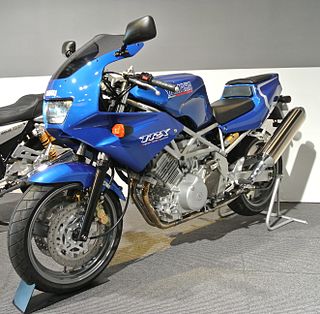
The Yamaha TRX850 is a sports motorcycle with a 10-valve DOHC 849 cc 270° parallel-twin engine. First released in Japan in 1995, a version for the European market was available from 1996 to 2000.
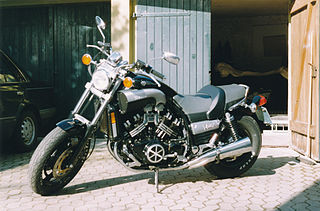
The Yamaha V-Max, cruiser motorcycle was produced by Yamaha from 1985. Known for its 70° V4 engine, shaft drive, and distinctive styling, the V-Max was discontinued following the 2020 model year.
BMW Motorrad is the motorcycle brand of BMW, part of its Corporate and Brand Development division. It has produced motorcycles since 1923, and achieved record sales for the fifth year in succession in 2015. With a total of 136,963 vehicles sold in 2015, BMW registered a growth of 10.9% in sales in comparison with 2014. In May 2011, the 2,000,000th motorcycle produced by BMW Motorrad was an R1200GS.

The Honda CBR1000F Hurricane is a sport touring motorcycle, part of the CBR series manufactured by Honda from 1987 to 1996 in the United States and from 1987 to 1999 in the rest of the world. It is powered by a liquid-cooled, DOHC, 998 cc (60.9 cu in), 16-valve inline-four engine. The CBR1000F, along with the CBR750F and CBR600F, was Honda's first inline four-cylinder, fully-faired sport bike.
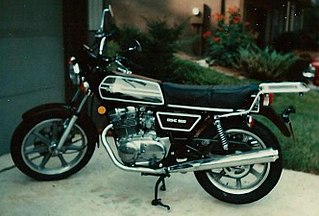
The Yamaha TX500 is a two-cylinder standard motorcycle built by Yamaha and sold in 1973 and 1974. Early models closely resembled the Triumph Bonneville in style. In 1975 the bike was renamed XS500 and then continued to be updated until 1978 when sales ended in the USA. In Europe, the model was available through 1980.
The Honda CB900F is a Honda motorcycle made in two iterations which appeared some twenty years apart. Both generations of the CB900F are straight four-cylinder four-stroke 900 cc (55 cu in) roadsters.
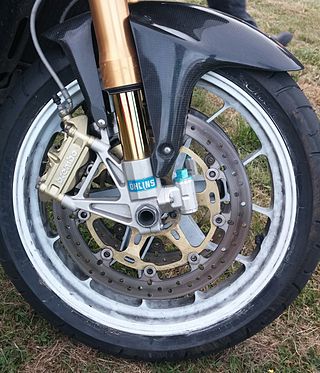
Motorcycle braking systems have varied throughout time, as motorcycles evolved from bicycles with an engine attached, to the 220 mph (350 km/h) prototype motorcycles seen racing in MotoGP. Most systems work by converting kinetic energy into thermal energy (heat) by friction. On motorcycles, approximately 70% of the braking effort is performed by the front brake. This however can vary for individual motorcycles; longer-wheelbase types having more weight biased rearward, such as cruisers and tourers, can have a`greater effort applied by the rear brake. In contrast, sports bikes with a shorter wheelbase and more vertical fork geometry can tolerate higher front braking loads. For these reasons, motorcycles tend to have a vastly more powerful front brake compared to the rear.
